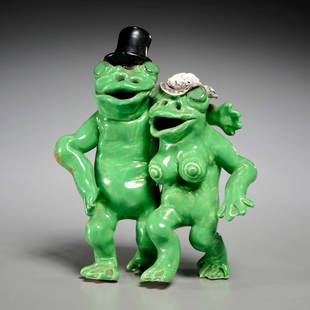
11th C. Khmer Stone Buddha on Naga Throne
Similar Sale History
View More Items in Sculptures & CarvingsRelated Sculptures & Carvings
More Items in Cambodian Sculptures & Carvings
View MoreRecommended Art
View More





Item Details
Description
Southeast Asia, Cambodia, Khmer Empire (Angkor culture), ca. 11th to 13th century CE. A monumental, finely carved stone Buddha, seated on a three-tiered serpentine throne, with the flaring, hooded head of a giant Naga, the serpent king Muchilinda, rising behind him protectively. The Buddha's hands are posed in the Dhyana Mudra. This is a gesture of meditation, with the hands placed in the lap, right hand on left, with fingers full stretched out and palms facing upwards. The Buddha's face is serene, with a naturalistic and warm expression. He wears a magnificent crown that was meticulously incised with intricate beaded and stylized geometric motifs, topped by a similarly elaborately detailed ushnisha, symbolizing his enlightenment. The serpent is well-rendered and symmetrical. While this artwork was religious - priests supervised its execution - its realism is unmistakable. Size: 15" W x 36.5" H (38.1 cm x 92.7 cm)
The Naga hood and throne comprised of the coils of the serpent's massive body suggest that Muchilinda is protecting the Buddha from heavy rain. This iconographic depiction of the Buddha was a popular one from the reign of Khmer King Jayavarman VII (reigned ca. 1181 to 1218 CE), who established a cult based around it. Scholars believe that this may be because Jayavarman was disabled, and snakes were associated with healing. Interestingly, the king is also known for the establishment of hospitals throughout his kingdom.
This said, some scholars question the Buddha/Muchilinda story, saying that it is based on a misreading of the sources. Naga cults were prevalent throughout Indian, Sri Lankan, and Southeast Asian artwork during this period, but the symbolism is somewhat unclear. Some have proposed that nagas could be symbolic vehicles for elevating the deceased ? equivalent to transcendence. This interpretation was inspired by the artwork of Angkor Wat and other parts of the Khmer world. Others see the inclusion of the naga as a holdover from earlier symbolic practices.
Formalistically, Khmer art moved away from Indian styles in the 7th century CE to encompass its own framework. One sign of this, seen here, is that this statue is carved in the round, rather than as a relief on a stela, which was subscribed to by Indian and Javanese Hindu and Buddhist sculptures that were previously influencing Cambodian art. From this, we can infer that Khmer sculptors would have desired their artwork to be viewed from all sides, and thus placed in the center of temples rather than against a wall.
Provenance: private Tucson, Arizona, USA collection, acquired in 2009; ex-Dorian Rae collection, Vancouver, British Columbia, Canada, established 1978
All items legal to buy/sell under U.S. Statute covering cultural patrimony Code 2600, CHAPTER 14, and are guaranteed to be as described or your money back.
A Certificate of Authenticity will accompany all winning bids.
We ship worldwide to most countries and handle all shipping in-house for your convenience.
#160561
The Naga hood and throne comprised of the coils of the serpent's massive body suggest that Muchilinda is protecting the Buddha from heavy rain. This iconographic depiction of the Buddha was a popular one from the reign of Khmer King Jayavarman VII (reigned ca. 1181 to 1218 CE), who established a cult based around it. Scholars believe that this may be because Jayavarman was disabled, and snakes were associated with healing. Interestingly, the king is also known for the establishment of hospitals throughout his kingdom.
This said, some scholars question the Buddha/Muchilinda story, saying that it is based on a misreading of the sources. Naga cults were prevalent throughout Indian, Sri Lankan, and Southeast Asian artwork during this period, but the symbolism is somewhat unclear. Some have proposed that nagas could be symbolic vehicles for elevating the deceased ? equivalent to transcendence. This interpretation was inspired by the artwork of Angkor Wat and other parts of the Khmer world. Others see the inclusion of the naga as a holdover from earlier symbolic practices.
Formalistically, Khmer art moved away from Indian styles in the 7th century CE to encompass its own framework. One sign of this, seen here, is that this statue is carved in the round, rather than as a relief on a stela, which was subscribed to by Indian and Javanese Hindu and Buddhist sculptures that were previously influencing Cambodian art. From this, we can infer that Khmer sculptors would have desired their artwork to be viewed from all sides, and thus placed in the center of temples rather than against a wall.
Provenance: private Tucson, Arizona, USA collection, acquired in 2009; ex-Dorian Rae collection, Vancouver, British Columbia, Canada, established 1978
All items legal to buy/sell under U.S. Statute covering cultural patrimony Code 2600, CHAPTER 14, and are guaranteed to be as described or your money back.
A Certificate of Authenticity will accompany all winning bids.
We ship worldwide to most countries and handle all shipping in-house for your convenience.
#160561
Condition
Surface with nice worn patina. Loss to one cobra head to upper left and another to lower right, wear at hands, minor losses and chips as shown.
Buyer's Premium
- 24.5%
11th C. Khmer Stone Buddha on Naga Throne
Estimate $20,000 - $30,000
7 bidders are watching this item.
Shipping & Pickup Options
Item located in Louisville, CO, usOffers In-House Shipping
Local Pickup Available
Payment

TOP




































































